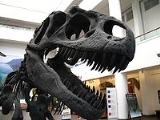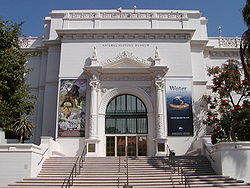
San Diego Natural History Museum
Encyclopedia

It is the third oldest scientific institution west of the Mississippi
Mississippi River
The Mississippi River is the largest river system in North America. Flowing entirely in the United States, this river rises in western Minnesota and meanders slowly southwards for to the Mississippi River Delta at the Gulf of Mexico. With its many tributaries, the Mississippi's watershed drains...
and the oldest in Southern California
Southern California
Southern California is a megaregion, or megapolitan area, in the southern area of the U.S. state of California. Large urban areas include Greater Los Angeles and Greater San Diego. The urban area stretches along the coast from Ventura through the Southland and Inland Empire to San Diego...
. The newest addition to the museum was dedicated in April 2001, doubling exhibit space.
First fifty years
.jpg)
Weather station
A weather station is a facility, either on land or sea, with instruments and equipment for observing atmospheric conditions to provide information for weather forecasts and to study the weather and climate. The measurements taken include temperature, barometric pressure, humidity, wind speed, wind...
, petitioned to create Torrey Pines State Reserve
Torrey Pines State Reserve
Torrey Pines State Natural Reserve is a coastal state park located in the California community of La Jolla, San Diego, California, off North Torrey Pines Road . Although it is located within San Diego city limits, it remains one of the wildest stretches of land on the Southern California coast...
, and garnered support for the San Diego Zoological Society.
In June 1912, the Society met for the first time in its new quarters in the Hotel Cecil, recently built on 6th Avenue in San Diego. Later that same month exhibits created by Frank and Kate Stephens were installed in a single room and adjoining alcove, and were open to the public several afternoons each week. The Society had opened its first museum.
In 1917, the Society purchased a vacant Balboa Park building from the 1915 Panama-California Exposition. Here the Society moved its growing collections and library to create the San Diego Natural History Museum. The Board defined its commitment "to educate and help people know and love nature" and began a variety of educational programs, many of them using specimens from museum collections in city and county schools.
The museum occupied three different buildings in Balboa Park before celebrating its 50th anniversary. Community leaders recognized the need for a permanent museum of adequate size. San Diego's leading architect, William Templeton Johnson
William Templeton Johnson
William Templeton Johnson was a notable San Diego architect. He was a fellow to the American Institute of Architects in 1939.Johnson is known for his Spanish Revival buildings, all in San Diego unless otherwise noted:...
(1877—1957) was commissioned by the Society of Natural History to design its new museum building on Balboa Park's East Prado. Johnson had earned his reputation with his design of the Fine Arts Gallery (now the San Diego Museum of Art
San Diego Museum of Art
The San Diego Museum of Art is a fine arts museum located in Balboa Park in San Diego, California that houses a broad collection with particular strength in Spanish art. The San Diego Museum of Art opened as The Fine Arts Gallery of San Diego on February 28, 1926, and changed its name to the San...
) and the downtown San Diego Trust & Savings Bank, among other buildings.
World War II
The Society was notified on March 5, 1943, that the United States NavyUnited States Navy
The United States Navy is the naval warfare service branch of the United States Armed Forces and one of the seven uniformed services of the United States. The U.S. Navy is the largest in the world; its battle fleet tonnage is greater than that of the next 13 largest navies combined. The U.S...
wished to take over the Natural History Museum for hospital use at once, becoming the infectious diseases ward. Some renovation took place in the facility, including the addition of an elevator designed to handle hospital gurneys and a nurses' station between floors. Both features remain in use today. The U.S. Navy takeover of the museum building for the duration of World War II resulted in damage to the collections, exhibits, and the building itself.
The main library and its librarian were moved to San Diego State College; the rest of the treasured and fragile exhibits were hastily packed, crated and moved into a total of 32 separate places. Exhibits too large to be moved were stuffed into the north wing on the main floor. A major renovation commenced once staff was allowed to reoccupy the building. Forced to look at all collections and exhibits in this rehabilitation process, the board adopted a firm policy to restrict collections to the southwestern United States and northern Mexico. The museum continued its steady growth with post-war San Diego, despite periods of financial stress. Staff upheld professional practices regardless of limited resources, and the American Association of Museums
American Association of Museums
The American Association of Museums is a non-profit association that has brought museums together since its founding in 1906, helping develop standards and best practices, gathering and sharing knowledge, and advocating on issues of concern to the museum community...
accredited the Museum in 1974.
Present building
The construction of the new headquarters was made possible through a grant of $125,000 from Ellen Browning ScrippsEllen Browning Scripps
Ellen Browning Scripps was an American philanthropist who was the founding donor of several major institutions in Southern California.-Biography:...
, and by public subscription. However, the full amount needed for the building could not be raised in the Depression
Great Depression
The Great Depression was a severe worldwide economic depression in the decade preceding World War II. The timing of the Great Depression varied across nations, but in most countries it started in about 1929 and lasted until the late 1930s or early 1940s...
years. Only the first unit of the building, at the south end of the lot, and one wing extending toward the north, could be built. The north and east exterior facades were left plain as temporary walls slated for future expansion, and remained so for 60 years.
The new $175,000 Natural History Museum building was formally dedicated on January 14, 1933.
Completed and dedicated in April 2001, new construction more than doubled the size of the old building, from 65000 square feet (6,038.7 m²) of usable space to approximately 150000 square feet (13,935.5 m²). The expansion provided new space for the Museum's research, educational, and administrative activities. Architects for the expansion were Dick Bundy and David Thompson. With the addition of the new wing to the Museum, areas for permanent exhibitions, such as Fossil Mysteries, were created along with five new exhibition halls. Also added, was a state-of-the-art theater with a 56' screen and a Dolby Digital 3D projector.
From June 29, 2007 to January 6, 2008, a collection of the Dead Sea Scrolls
Dead Sea scrolls
The Dead Sea Scrolls are a collection of 972 texts from the Hebrew Bible and extra-biblical documents found between 1947 and 1956 on the northwest shore of the Dead Sea, from which they derive their name...
were on display to the public – ten of them for the first time ever. The attendance was nearly 400,000, which was a record for any exhibit at the museum.
In December 2009, the San Diego Natural History Museum was awarded Leadership in Energy and Environmental Design
Leadership in Energy and Environmental Design
Leadership in Energy and Environmental Design consists of a suite of rating systems for the design, construction and operation of high performance green buildings, homes and neighborhoods....
for Existing Buildings: Operations & Maintenance (LEED-EB: O&M) Certification, becoming one of the oldest, privately-owned institutions to achieve the award.

